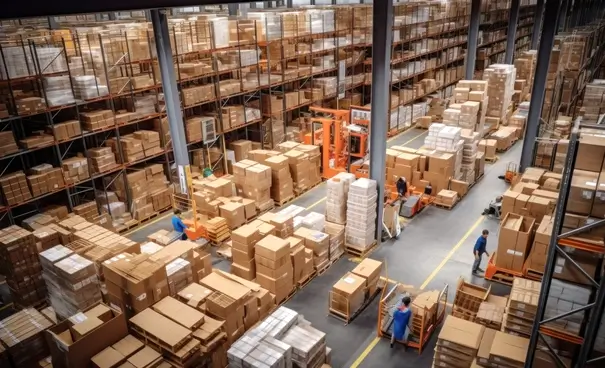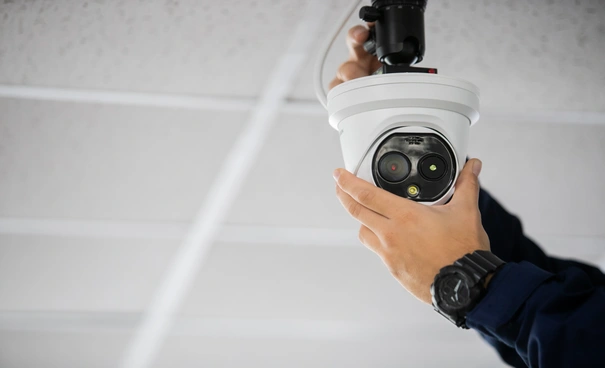Warehouses are treasure boxes for thieves because of their high-value inventory or finished goods, stacked from floor to ceiling!
Warehouse owners and managers across Canada are frustrated due to inventory shrinkage, internal theft, fires, intrusions, and cargo theft from loaded trucks.
Despite the significant trend towards deploying CCTV surveillance for real-time warehouse security monitoring, the effectiveness of such monitoring by warehouse managers remains a concern.
This article will help you understand how you can improve the quality of live monitoring to enhance warehouse security. Join us as we discuss how advanced video analytics are changing the security paradigm.
Finally, we also share a few hints and tips with you to help improve the standard of warehouse security.
Let’s pause to grasp the magnitude of this security challenge for warehouse owners in Canada.
How catastrophic are security issues in Canadian warehouses?
External theft:
- Police seized $350K+ in stolen items from a Brampton warehouse.
- A man was charged with stealing $5K+ worth of electronics from a Caledon warehouse.
It is a good thing the police apprehended the robbers for the above warehouse owners! Not all of them are as fortunate!
Internal theft:
An even more significant issue that warehouse owners deal with is internal theft! Indeed, dishonest workers do not think twice about seizing the chance to make money on valuable inventory or cash!
They may also occasionally act as an enabler for outside thefts, which can cost you thousands of dollars.
Employee safety:
Surprising statistics highlight worker safety concerns in warehouse security. Amazon, hosting one of the world’s largest warehouse networks, reported 38,334 employee injuries, indicating a high rate of accidents.
In order to eliminate hazards in the workplace, OSHA enforces health and safety regulations that are mandatory for workers in Canada.
Fire:
Many warehouses and storage areas across Canada have burned down due to fires, whether intentional or accidental. According to a report, there were a total of 1,004 fires in 2021, causing huge financial setbacks.
Warehouses can benefit from the following smoke and fire detectors to prevent fire:
Multi-sensor detectors: Combine smoke and heat detection for better accuracy in environments with dust or high humidity.
Aspirating Smoke Detectors (ASDs): Sample air continuously through a network of pipes, offering high sensitivity for early fire detection, especially in large warehouses
Video Analytics: Use cameras with intelligent software to detect smoke or unusual heat patterns. We will discuss this further in the blog. Keep reading!
What is live monitoring for warehouse security?
Live monitoring means the use of surveillance cameras to quickly detect and act on security breaches.
These cameras, when enabled with AI, become even more powerful crime detection tools. Faster detection means more chances of catching the criminal while the crime is in progress.
Vigilant monitoring of the numerous activities and areas is crucial for maintaining comprehensive checks and control. The sometimes remote locations of these warehouses make them difficult to secure and give thieves a way to plan criminal acts.
A good warehouse security system consists of cloud storage, intelligent analytics & a unified platform. That is exactly what remote video monitoring helps you to achieve:
- All video feeds are recorded and stored in cloud storage, simplifying the saving and management of footage in an online system.
How do you benefit? This setup allows you to access both live and recorded videos from anywhere with an internet connection, enabling the convenient monitoring and analysis of multiple warehouses simultaneously.
- Cameras equipped with AI solutions enhance the effectiveness of proactive security measures.
How do you benefit? The system studies patterns in data, allowing it to predict and identify potential threats accurately.
- A unified platform means centralized management of diverse security components. Remote operators can monitor and respond quickly to different security aspects.
How do you benefit ? Security operators at a remote monitoring center facilitate smooth coordination and collaboration among different security features.
Enhancing security can significantly reduce theft and product tampering, potentially saving businesses thousands of dollars.
To address these concerns, we’ve compiled a checklist of four strategies to improve the quality of live monitoring for warehouses:
- Step #1 Assess what needs to be secured.
- Step #2 Install devices for warehouse security.
- Step #3 Solidify perimeter security.
- Step #4 Strengthen your access security.
Practices to Improve Live Monitoring Quality:
Practice #1: Assess what needs to be secured.
The first step is to conduct a security audit to assess what needs to be secured and how much protection you need.
With the average Canadian warehouse size doubling since 2002, the approximate size is nearly 17,500 square feet.
Smaller warehouses can be around 1,000 square feet, still needing robust security.
This calls for a comprehensive audit, which is crucial to identifying vulnerabilities and implementing a tailored security system.
What to secure in a warehouse?
Securing a warehouse means, in fact, securing the premises, inventory, and personnel of the warehouse. The operations will run more smoothly once these three crucial points are covered.
The best method of surveillance is to use strategically positioned CCTV cameras throughout the warehouse.
A professional security installer will help you figure out where and how to place the security cameras. It is important that you also know how the warehouse is set up and what things might need extra protection to keep them safe.
This analysis will help you identify security gaps, it will also identify areas that need special cameras or locks.
The physical security measures can be made more effective by introducing a supplementary layer of advanced technology, specifically through remote video monitoring.
Practice #2: Installing security devices for warehouse security.
Preventing warehouse theft is a priority, requiring a combination of surveillance and access control.
Inventory tracking system/inventory management system.
There are many different inventory tracking/management systems. Being able to keep track of your inventory digitally, and taking the time to audit the accuracy of your data, makes it less likely that internal theft will occur and more likely that you’ll recover lost assets if it does.
Best Tracking Products for Warehouses.
Barcode Scanners:
An affordable and simple solution for tracking inventory movement. Integrates well with existing warehouse management systems. Zebra Technologies (zebra.com) and Honeywell (honeywell.com) are major brands.
Real-Time Location Systems (RTLS):
Uses various technologies like Wi-Fi or Ultra-Wideband (UWB) for precise asset tracking indoors. Ideal for high-value items or equipment. Companies like Awarepoint (awarepoint.com) and Pointr (pointr.com) specialize in RTLS.
Security cages:
If you want to add another secure perimeter inside your warehouse consider security cages. You can better protect dangerous or expensive industrial equipment and supplies from theft or damage in a security cage.
You can control who accesses these specific items with an access control system.
The doors of these security cages can be locked by using RFID readers, enabling access to only the people you give the authority to. You can use :
Keypads:
Simple and affordable, offering PIN code access. Popular brands include HID Global and alarm.com.
Key cards/fobs:
More secure than keypads, offering contactless access. HID Global is a major player here too.
Biometric readers:
Highest security, using fingerprints or even iris scans. More expensive but ideal for high-value cages.
Securing doors and windows.
To enhance the quality of live monitoring in various areas, consider utilizing door sensors designed to detect the status of doors.
These sensors can be strategically placed within a warehouse, either on the top or side of a door and they can also be used to secure windows.
They use an infrared and microwave combination sensor. The infrared sensor is sensitive to heat, making it effective in detecting living beings, while the microwave sensor can detect motion even in challenging conditions.
The combination enhances the accuracy of motion detection and reduces false alarms, thus providing a more reliable warehouse security system.
Optex activation and safety sensors include a presence detection area to detect people who are even hanging around the threshold of the door.
In the event of a breach in monitored zones, these sensors trigger alarms.
When sensors are linked to a remote video monitoring center, an operator immediately accesses the camera overseeing the triggered sensor’s area upon an alarm.
They assess the situation, confirm any breach, and respond following the client’s SOPs.
Alarm systems:
Implementing alarm systems involves strategically placing sensors at vulnerable points within the warehouse. These sensors are designed to detect unauthorized access, movement, or any suspicious activities.
Alarm systems act as a powerful deterrent, as potential intruders are aware that any breach will trigger an immediate alert. This discourages unauthorized access and reduces the risk of theft.
However, the biggest problem with these alarm systems is that even a stray cat, or a squirrel may trigger the alarm. And these false alarms cause you big penalties!
One way to confirm if alarms are legit is to use alarm video verification. As soon as the alarm is triggered, the remote operator accesses the live video feed of the camera in the zone of the triggered sensor. They then assess whether the triggered alarm is real or fake.
Read our most recent blog to learn more about how alarm video verification can save you from false alarms and enhance the integrity of your alarms!
Source: How does video verification alarm system works?
Install CCTV cameras:
Real-time warehouse monitoring primarily consists of CCTV surveillance cameras strategically placed at various locations within the warehouse.
Importantly, the top security cameras for enhancing warehouse security include brands like BOSCH, Axis, and Avigilon. These cameras, notably, are particularly suitable to meet the unique security needs of warehouses.
Consequently, here we’ve explored various types of cameras for real-time warehouse monitoring systems, specifically aimed at enhancing security and safety measures.
- Dome cameras: They have a dome-shaped housing, providing a sleek and often vandal-resistant design. You can use them both indoors and outdoors.
They offer a 360-degree view and yet their shape makes it challenging for individuals to discern the direction the camera is pointing. For visibility in dim, isolated places, an axis lightfinder is perfect.
- Bullet camera: Use bullet cameras to cover long aisles where a focused and long-distance view is required. They can also prove their efficacy along the exterior perimeter to monitor and deter unauthorized access.
Bullet cameras give a fixed view. They are ideal for monitoring specific zones requiring detailed and continuous surveillance.
- LPR cameras: Installing special license plate recognition cameras is a great option because it captures a clear, high-quality image of the license plate and stores it in a database.
Good LPR cameras should be placed at the entrances and exits of warehouses to log license plate information for access control, parking management, and investigation assistance.
- IP camera: Gone are the times when security officers in warehouses would merely sit and watch screens while utilizing CCTV cameras. IP cameras use digital technology to transmit video data over an IP network.
They offer higher resolution than analogue cameras, providing clearer and more detailed images. This can be beneficial for identifying objects and individuals through real-time monitoring.
This allows for remote monitoring and management via computers or mobile devices.
These cameras, when connected to a remote monitoring center, allow operators to manage multiple locations and quickly respond to alarms.
Here are some warehouse locations where installing CCTV cameras can improve security:
| Location | What to secure |
|---|---|
| Entry and Exit Points | To monitor main entrances, loading docks, and exit doors to track the flow of people and goods. |
| Perimeter | To cover the exterior perimeter of the warehouse to deter unauthorized access and detect any suspicious activity outside. |
| Aisles and Corridors | To monitor movement within the warehouse, helping to prevent internal theft or unauthorized activities. |
| High-Value Areas | To focus on areas where valuable inventory is stored, ensuring close monitoring of assets. |
| Parking Lots | If applicable, extend surveillance to the warehouse’s parking lots to enhance overall security. |
| Machinery and Equipment | Monitor critical equipment, machinery, and high-risk zones to prevent accidents, damage, or unauthorized use. |
Such camera placement would significantly reduce blind spots and enhance security.
Recommended height for the cameras:
Now that we’ve identified the crucial locations for camera placement, let’s discuss the optimal height for their installation.
Canadian warehouses are growing vertically in order to maximize available space. For example, some warehouses now have heights of 36 feet, much higher than the standard 26 feet.
As is clear, when heights reach 36 feet and racks gets taller, your cameras must be placed according to the height of the racks:
Low Racks (Up to 12 Feet): Install cameras at eye level or slightly above to capture facial details and activities on lower shelves.
Medium Racks (12 to 24 Feet): Position cameras at a higher vantage point, ensuring coverage of mid-level racks while maintaining visibility of lower shelves.
High Racks (24 to 36 Feet and Beyond): Install cameras at elevated positions to cover the entire height of the racks. Consider a combination of high-mounted and pan-tilt-zoom (PTZ) cameras for flexible monitoring.
Lighting:
Warehouses, vast and often situated in remote locations, demand specialized lighting both indoors and outdoors due to their minimal windows, high ceilings, and tall shelving, necessitating powerful illumination for different areas.
Shadows cast by tall, horizontally stacked inventory can create dim and dark secluded spots.
Therefore, efficient lighting is required.
Here are a few options:
- Linear LED High Bays :
Aisles, loading dock interiors, entrances, warehouse walkways, and assembly lines are all excellent places to use it.
LED High Bays:
Use for general area lighting in warehouses and other industrial spaces where a bright, wide light pattern is needed.
LED Strip/Shop Lights:
LED lighting is beneficial for all low-ceiling areas in the warehouse, such as storage rooms, workshops, inspection stations, and other places where light directly affects the quality of work.
LED lights placed along the perimeter can improve visibility and security of the warehouse even at night.
For license plate recognition cameras, lighting can be placed above the camera. Mounting cameras at a height of three to four feet off the ground, with light above them ensures they’re in the perfect position to capture clear images.
Practice #3: Perimeter security.
Securing the perimeter is the most vital step in protecting everyone both inside and outside the building.
Given that warehouses often reside in secluded locations, implementing security measures to establish barriers that prevent trespassers from climbing, cutting through, or going through the fence is essential.
Make sure the warehouse perimeter is secured with sturdy gates, fences, barriers, lighting, and nearly every other safety precaution you can think of!
Practice #4 Access security.
Prevention is crucial when managing facilities with assets, a large workforce, and regular visitor and truck traffic. This makes us think about how essential it is to supervise and keep track of who goes into the warehouse.
It is also critical to know who can access what locations once they are inside the warehouse. Strong access control allows you to strictly limit entry to those individuals who are authorized.
RFID access to employees in the warehouse.
RFID, or Radio-Frequency Identification, is commonly used in warehouse management and logistics. Specifically, it tracks and manages employees’ entry and exit, as well as their movements to various areas.
Additionally, integrating warehouse RFID systems with remote video monitoring offers an effective access control solution.
Consequently, this combination enables sophisticated management, where employees use RFID tags or badges to deactivate warehouse security alarms upon entry.
Separate tags that allow for the logging of their movements from one zone to another can be applied to individuals entering specialized areas, like security cages.
Granting warehouse workers RFID access yields the following benefits:
- Ensure accurate tracking and limit access effortlessly.
- Monitor employee movements with streamlined efficiency.
- Manage access rights and track personnel movements.
How does an access control system work with remote video monitoring?
With remote gate access control, you can grant the remote operator full or partial access as soon as a visitor or employee arrives at the gate.
The remote operator has one-way video and two-way audio to interact with the individual at the gate. The operators verify credentials, ask questions, and grant entry only to authorized individuals.
The main advantage is that you have complete control over who enters and when. You can also decide to close or lock the warehouse gates at certain times, which will prevent both pedestrian and vehicle access.
Cameras equipped with AI solutions can trigger alarms at the remote monitoring center when suspicious activity is detected near the gates for quick review by security operators.
Hence, you can protect your warehouse from potential threats like theft, damage, or loitering.
To find out how remote gate access control can boost warehouse security, read our most recent blog. It will dispel any doubts you may have regarding access control.
Customized services for real-time warehouse monitoring:
Remote video monitoring is a cost-effective option for large warehouses looking to replace security guards.
What is a virtual guard tour?
Remote operators, just like on-foot patrols would do, log into a series of camera in a precise order and at specific times during the day or night to check for suspicious activity or situations such as loitering, flood, smoke, fire, a person on the ground, a door ajar, overcrowded areas, and more.
If the operator detects anything out of the ordinary, they swiftly follow the client’s SOPs until resolving the problem.
This solution is the perfect synergy of human expertise and advanced technology.
- Advanced AI analytics:
To enhance the comprehensiveness of a security solution for the warehouse, it’s crucial to maintain a close watch on every facet of the operation.
Consequently, by leveraging advanced video analytics, artificial intelligence integrated with cameras can swiftly detect security breaches, ensuring a seamless security protocol.
This dynamic combination of modern AI surveillance and CCTV cameras allows for quick detection of falls, fires, and intruders. Let’s look in detail:
Warehouses, often filled to capacity with priceless inventory, can become vulnerable to fires during extreme heat or dry weather conditions.
You can enhance the live monitoring to another level by incorporating a smoke and fire detection AI solution. As soon as the camera AI detects early signs of fire hazards, it sets off the alarm at the remote video monitoring center.
The skilled operators at the remote video monitoring center gain prompt access to the cameras and assess the situation. The operator initiates an emergency reaction in accordance with the SOPs of the client.
This solution shields warehouse owners from significant financial losses and protects employees’ lives.
Live monitoring not only enhances the security of your inventory but also enhances the safety of your personnel. The camera AI detects any slip and fall and triggers an alarm at the remote monitoring center.
By using real-time video feeds, the remote operator rapidly assesses the situation and responds in line with the client’s standard operating procedures.
Tips for improving warehouse security.
To enhance warehouse security:
- Employee Training
- Conduct mandatory security awareness training for all new employees. Cover topics like access control, recognizing suspicious activity, and reporting procedures.
- Hold quarterly refresher training sessions to reinforce security protocols and address any recent security incidents.
- Physical Security
- Ensure all exterior doors have functioning deadbolts and heavy-duty hinges. Consider upgrading to key card or biometric access control systems.
- Invest in high-quality security cameras with clear views of entrances, exits, loading docks, and high-value storage areas.
- Access Control
- Disable access cards or fobs for any terminated employees immediately.
- Implement a system for logging visitor access, including time in and time out. Require visitors to wear identification badges.
Advantages of live monitoring for enhanced warehouse security.
Reduced inventory shrinkage:
Live monitoring helps prevent and promptly address inventory shrinkage. The camera AI can quickly detect security breaches and suspicious behavior, helping with crime prevention and fast problem resolution.
Moreover, the mere presence of security cameras and signs deter criminals who do not want to be filmed while committing theft.
Live monitoring can also identify inventory mishandling by employees and thus minimizes losses.
Alerts and alarm verifications:
Immediate notifications and verified alarms facilitate quick action against potential security threats. Moreover, remote operators rapidly address triggered alerts, ensuring prompt intervention and resolution.
Furthermore, verifying alarms minimizes false alarms, thereby strengthening their reliability and ensuring authorities react quickly in genuine emergencies.
Optimized operations:
Live monitoring significantly contributes to operational efficiency by providing real-time insights into warehouse activities.
Moreover, cameras installed throughout the warehouse furnish managers with remote access, thus offering a comprehensive 360-degree view of operations.
Consequently, this enhanced visibility enables more effective resource allocation and process optimization.
Enhanced emergency response:
Live monitoring allows for the prompt identification of emergencies. This allows faster and more effective responses to incidents.
So if an intruder tries to break-in, the camera AI swiftly identifies the intrusion and triggers an alarm at the remote monitoring center.
As soon as the operators assess the situation, they either intervene with audio interventions or act according to SOPs set by the client.
Reduced insurance premiums:
Higher thefts also result in higher insurance premiums and lower customer satisfaction and trust. The implementation of live monitoring systems shows your commitment to security.
This leads to reduced insurance premiums as it lowers the risk of losses and damages.
Conclusion:
Warehouse security is a critical concern due to the inherent risks of theft, fires, unauthorized access, and other security threats.
To enhance the quality of live monitoring for warehouse security, a comprehensive approach is crucial. Conducting a security audit, implementing advanced video analytics, and adopting a unified platform with cloud storage are key steps.
When you combine AI-driven cameras and remote video monitoring, you get proactive detection and swift action against security breaches!
Contact us for a customized warehouse security solution. If you have any comments or questions regarding warehouse theft and prevention, please don’t hesitate to leave a comment below.
































































